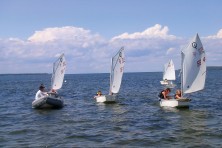Training Pays Off in Kayaker Rescue
- Share
- Tweet
- Pin
- Share
It was noon on June 8 when Brody Kidd saw a group of kayakers and canoers struggling in the water near Cave Point County Park.
Even after four years guiding for Door County Kayak Tours, he had never seen anything like this. Three people stuck in the 54-degree water, two in hypothermic shock. There were two people in a canoe trying to help, but they were unable to pull anyone out of the water without falling in themselves.
But Kidd knew what to do and jumped in a kayak after calling for help. He towed another kayak behind him, and one of the people in the water had the strength to climb in. Kidd and that individual pulled the two people in hypothermic shock out of the water and paddled back to shore.
“We just got done with intensive training, which I led, so everything was really fresh,” Kidd said. “It was just one of those crazy, lucky things that we showed up.”
When Kidd and the kayakers got to shore, they performed basic first aid for hypothermic shock victims until the paramedics and first-response team arrived. The two hypothermic kayakers were taken to the Ministry Door County Medical Center, and the others returned home.
This isn’t the first water-related rescue of the year for the Door County Sheriff’s Department.
“This is nothing unusual,” said Gary Behling, chief deputy of Door County. “We are getting more and more kayakers in the waters off of Door County, and with that number there’s going to be more calls.”
The Door County sheriff’s department received 34 water-related emergency calls in 2011.
The incident report from the Door County sheriff’s department estimates the group of kayakers and canoers were half of a mile from shore. Kidd said the two kayakers in hypothermic shock had been in the water for 90 minutes and weren’t wearing life jackets.
“That was probably one of the reasons why they went into hypothermic shock a little bit quicker,” Kidd said. “They were using a lot of their energy to stay above the water.”
Kayak Safety Tips
Courtesy of Casey St. Henry, program director at Bay Shore Outdoor Store
• Use common sense.
• Dress for the temperature of the water, not the temperature of the air. If the water is cold, like it is now in the early season, be prepared to be wet, not prepared to be in the sun.
• Know your limits. If you don’t kayak a lot, don’t go out when it’s wavy or when you don’t know the weather forecast.
• If you’re unsure about the conditions, call a local outfitter and ask for advice.
• Don’t go too far offshore.

